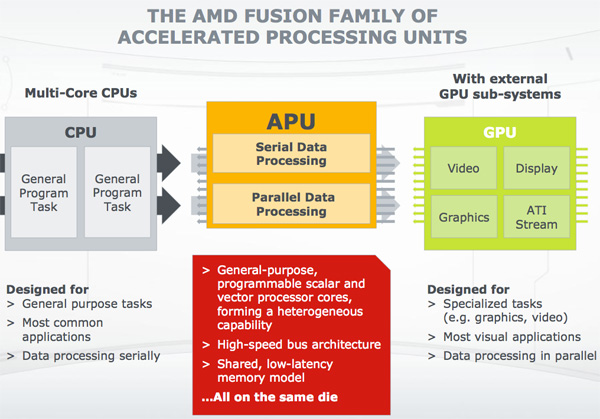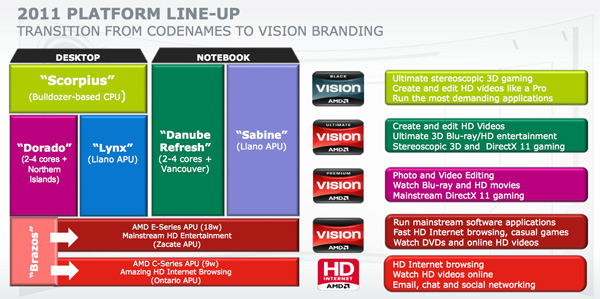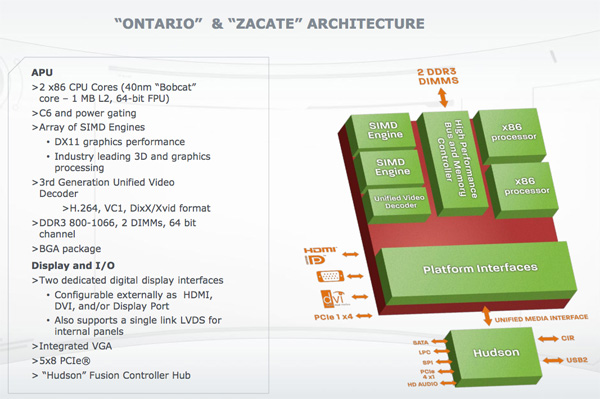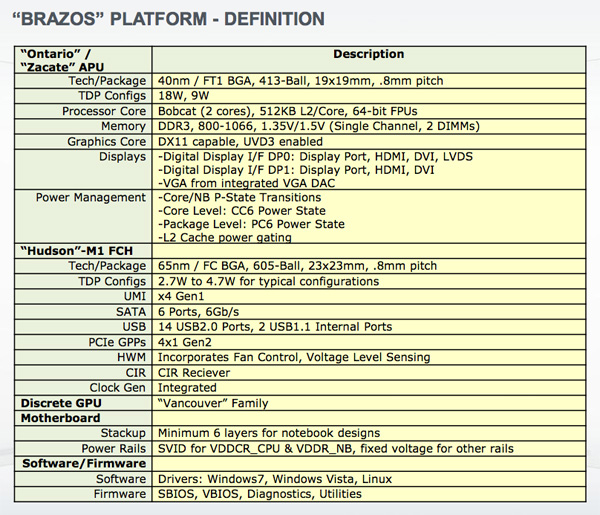Previewing AMD's Brazos, Part 1: More Details on Zacate/Ontario and Fusion
by Anand Lal Shimpi on November 9, 2010 1:09 AM ESTMeet the Brazos
The platform is called Brazos. Brazos encompasses two chips: a Zacate or Ontario APU (Accelerated Processing Unit) and the Hudson Fusion Controller Hub (FCH). This is the whole reason AMD bought ATI, Zacate and Ontario are its first CPU-GPU hybrids.
While AMD is primarily targeting the netbook/ultraportable and notebook markets with Ontario and Zacate (respectively), we’ll also see nettops/desktops and mini-ITX motherboards based on Brazos. This may be the first time we see real competition to NVIDIA’s ION platform.

AMD's Zacate APU, 19mm x 19mm package, 413 balls, 75mm^2 die
Both APUs are built from the same die. Zacate and Ontario are physically identical, they just run at different clock speeds. The 40nm die is manufactured at TSMC and measures 75mm^2. The chip is very cheap to package as well. The BGA package only has 413 balls. As one AMDer put it, these chips are designed to be stamped out as quickly and as cheaply as possible.
Both are available in single and dual core versions, although the single core variant is just a dual-core chip with one core disabled to hit various market segments. Core unlocking is apparently possible, but unexpected given the target for these platforms and the amount of effort OEMs would have to go to in order to enable it.
The CPU cores are based on AMD’s first truly low power client architecture, codenamed Bobcat. We’ve discussed Bobcat in great length already, but at a high level it looks a lot like an out-of-order Atom processor without Hyper Threading. The fundamental architecture advantage should give Bobcat the performance advantage over Atom, at least at identical clock speeds.
The GPU is based on AMD’s 5000 series architecture (Evergreen) and features 80 shader cores and AMD’s new UVD3 decode engine.
The SKUs
At launch you’ll see four SKUs, the combinations and specs are listed below:
| AMD Brazos Lineup | ||||||||
| APU Model | Number of Bobcat Cores | CPU Clock Speed | GPU | Number of GPU Cores | GPU Clock Speed | TDP | ||
| AMD E-350 | 2 | 1.6GHz | Radeon HD 6310 | 80 | 500MHz | 18W | ||
| AMD E-240 | 1 | 1.5GHz | Radeon HD 6310 | 80 | 500MHz | 18W | ||
| AMD C-50 | 2 | 1.0GHz | Radeon HD 6250 | 80 | 280MHz | 9W | ||
| AMD C-30 | 1 | 1.2GHz | Radeon HD 6250 | 80 | 280MHz | 9W | ||
Zacate takes the top two SKUs, while Ontario makes up the bottom two. The difference in TDP is entirely based on the clock speed of the CPU and GPU. And here is my concern. While a pair of Bobcats running at 1.6GHz are just awesome, drop the clock to 1.0GHz and I start getting concerned about performance. AMD didn’t let us test the C-50 but I’m curious to see what the margin of victory will be over Atom at that speed.
The GPU runs at 500MHz at the high end (Radeon HD 6310) and 280MHz at the low end (Radeon HD 6250). This paired with the single channel DDR3-800/1066 memory bus that has to be shared with the Bobcat cores means you should expect sub-5450 levels of performance out of these systems. Given their price point, that’s potentially not too bad. More enticing however is the fact that these APUs gain the benefit of the driver work AMD does on its discrete cards. Finally, game compatibility should be just as good on the low end as it is on the high end - assuming you meet the minimum specs for the title you’re running.
The lack of a brand for the CPU is a bit puzzling, but graphics are where it’s at these days.














106 Comments
View All Comments
Anand Lal Shimpi - Tuesday, November 9, 2010 - link
Fixed :)Take care,
Anand
hvakrg - Tuesday, November 9, 2010 - link
Is there any news on wether or not these Atom competitios will be able to bitstream audio?jabber - Tuesday, November 9, 2010 - link
....had to play on looks a little more complete than the spaghetti fest you chaps got.ET - Tuesday, November 9, 2010 - link
I was hoping that Ontario will bring a significant performance jump over dual core Atom + Ion 2. While there's still a chance it will be faster, I don't think it will be by much.I guess I will have to continue to wait (maybe forever) for a low end platform that would be good for basic gaming. I would happily give up DX11 to get twice as many DX9 cores.
Aone - Tuesday, November 9, 2010 - link
What will we see if we pair mobile Athlon with mobile discrete Radeon 54xx?Will Brazos have the same perf, better or worse?
Lolimaster - Tuesday, November 9, 2010 - link
Fusion Ontario/Zacate has the same performance of current Athlon II / Turion II Neo (same performance as regular (Athlon II).Zacate GPU has lower clocks than of HD5400(500Mhz vs 650Mhz). That's the main difference.
Why people mention CULV when Athlon II / Turion II are there and destroy those options as a cpu/gpu combo(equal cpu perf. way way better gpu perf.)
80SP AMD GPU already surpass ION2 GPU.
ET
What dissapointing? Look any comparison of the current 45nm Neo's, it's a slaughter for the poor Atoms, you'll see the same slaughter with Brazos but with improved battery life and the better gpu(twice the HD4250)
Shadowmaster625 - Tuesday, November 9, 2010 - link
If that thing really uses 4.7W its game over for AMD. No way should that part consume more than a watt. It should not even be there at all. Cant netbook manufacturers skip it entirely, and just go with a low power usb chip instead? What else do you need the FCH for on a netbook or a tablet?llllllllll - Tuesday, November 9, 2010 - link
Eh, the range was 2.7-4.7W TDP, which doesn't imply average power, just max for designing the enclosure.Also, considering 3W is typical for a DIMM of memory, and this thing is driving up multiple SATA, PCI-E, & USB ports (which remember, you have to be able to charge devices over USB), doesn't seem unreasonable that under load it would draw that much power.
Zstream - Tuesday, November 9, 2010 - link
How did you come to this conclusion?"Zacate takes the top two SKUs, while Ontario makes up the bottom two. The difference in TDP is entirely based on the clock speed of the CPU and GPU. And here is my concern. While a pair of Bobcats running at 1.6GHz are just awesome, drop the clock to 1.0GHz and I start getting concerned about performance. AMD didn’t let us test the C-50 but I’m curious to see what the margin of victory will be over Atom at that speed."
If you believe it is 100% on clock speed, we have a ton of leakage.
JarredWalton - Tuesday, November 9, 2010 - link
Doubling the maximum GPU speed and increasing CPU speed 60%, plus added voltage to get it to run properly, could easily result in a doubling of maximum power use.